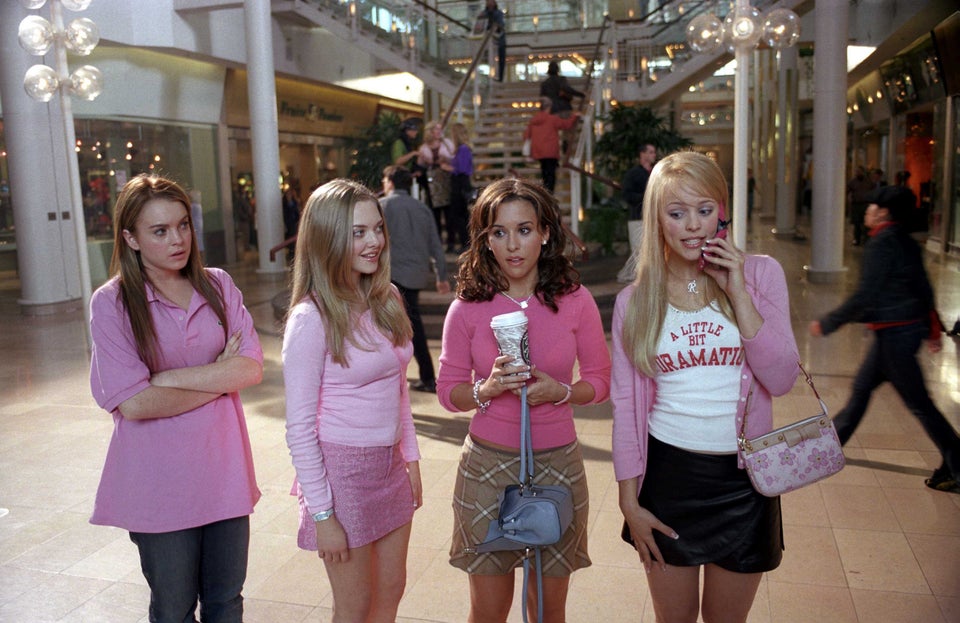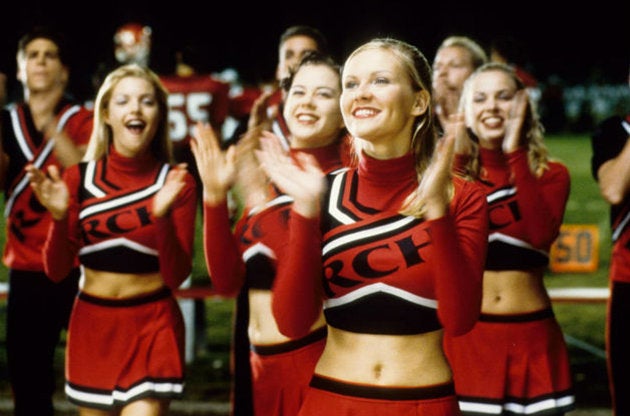
The word "cheerleader" is so laden with potential cultural meaning, it feels more like a theoretical concept than a noun usually meaning "person who leads cheers."
As a sport, cheerleading has been steadily gaining respect since the turn of the 21st century. As an archetype, it has shriveled into a token of hypersexuality and the nastiest teen girl stereotypes, a sort of shorthand for the terms "mean girl," "slut" and "dumb blonde," all stuffed into the same midriff-baring uniform.
The way she has transformed in pop culture -- as an expression of popularity, desirability and ditziness -- is perhaps one of the most extreme ways fictional representation has hijacked our perception of women. The cheerleader we see across film and TV is not just the typical fun-house mirror reflection churned out by Hollywood. By the late '90s, the cheerleader had morphed so drastically she became more of a symbol than a real person. That is, until the release of "Bring It On."
The film, which celebrates its 15th anniversary on Aug. 22, marks a pivotal shift for the figure. We were introduced to the Rancho Carne Toros at the peak of the cheerleader's rise in teen films, and their myth busting of the cheerleader cliche marked a clear decline in her presence on screen. It's as if "Bring It On" opened and shut the door on smart takes on the archetype. Now, a decade and a half later, the cheerleader of pop culture is seemingly on the verge of extinction.
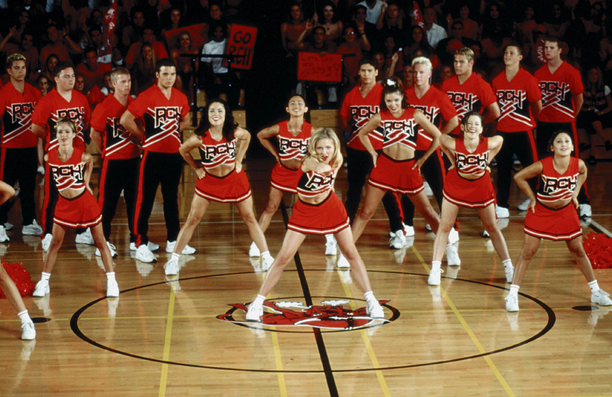
The reigning prototype for the cheerleader by the year 2000 was a sort of Frankenstein's monster, cobbled together from dismissals of youth and femininity into a portrait of the beautiful American girl at her ugliest -- an idea which "Bring It On" immediately sets out to dismember.
"I'm sexy, I'm cute, I'm popular to boot," sings Lindsay Sloane as Big Red in the punched-up opening scene. "I'm bitchin', great hair, the boys all love to stare. Don't hate us 'cause we're beautiful, 'cause we don't like you either. We're cheerleaders."
“Cheerleaders were so stigmatized as inherently ditzy and superficial figures that everyone from executives to potential actors assumed a movie about them would be just that."”
The song provides a satirical definition for the societal understanding of cheerleaders at the time, while the Busby Berkeley-style choreography that accompanies it functions as a pitch-perfect introduction to the tone of the movie that follows. If director Peyton Reed had opted for a more typical '90s teen movie opening -- maybe a tracking shot over an outdoor Cali high school, scanning over huddled cliques with a stoner zipping by on a skateboard -- "Bring It On" would be totally different.
"There was talk of cutting the opening number, and I just threw myself on the sword," writer Jessica Bendinger told The Huffington Post. "I was like, 'If you cut this cheer, then it’s just a dumb movie! Who cares?' You need to let everybody know your tongue is in your cheek. There needs to be self-awareness." Self-awareness, that is, as a cue to the audience that it was OK they were about to watch a movie about cheerleaders.
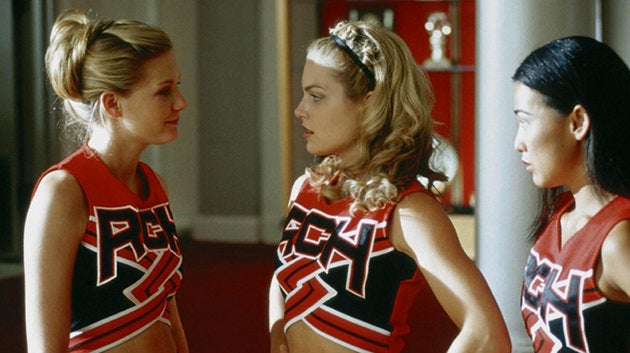
Nearly everyone who worked on the film joined on with their very own cheerleader prejudice in need of unpacking.
Getting studios interested in "Bring It On" was a struggle for Bendinger. She spent months pitching the script, then called "Cheer Fever." Driving around Los Angeles in her unairconditioned Saab, she got more than 27 rejections before the eventual green light from Beacon Communications. Even after that, it was difficult to get a director and cast to sign on.
Beacon agreed to produce the film with a distribution deal through Universal (who had initially passed on Bendinger's pitch). Fifteen years later, it's clear they never could have known it would yield a small franchise now including a musical. Cheerleaders were so stigmatized as inherently ditzy and superficial figures that everyone from executives to potential actors assumed a movie about them would be just that.
"I always wanted to direct a high school movie, but I never thought it would be a cheerleading movie," admitted Reed. He read the script with all of pop culture's pre-fab notions attached to the figure.
"Before, cheerleaders were mostly fall characters in movies," he explained. "They were usually meant to represent the status quo or the snobby kids. There’s also a large degree of cheerleader movies that exploit the sexuality of cheerleading. This was kind of different."
Once Reed was on board, his vision helped bring on Kirsten Dunst, who turned down the lead role of Torrance after an initial reading of the script, and Jesse Bradford, who eventually joined on to play her edgy rocker of a romantic interest, Cliff.
“The goal was to re-contextualize cheerleaders, so they weren’t the people you hated."”
- Peyton Reed
Bradford also approached the film doubting whether the cheerleader could be taken seriously.
"As a 20-year-old kid or man or man-child, whatever you wanna call me back then, I had my reservations about being in a cheerleader movie," Bradford said. "But I sat with Peyton and he showed me he wasn't a guy who wouldn’t be directing a cheerleading movie for the sake of directing a cheerleading movie. This movie was going to be more than that."
There's almost a desperation in the voices of the cast and crew, a need, even with the hindsight of their success, to let you know they were in on the joke from the start. The creatives behind "Bring It On" didn't just have to convince audiences to watch a cheerleading movie, they had to convince themselves to make it.
By 2000, treating "cheerleader" as a loaded term seemed as natural and automatic to teen movies as the propensity for high school to be an emotional hellscape. It almost seems odd to question the origin of the figure. But while the cheerleader of the '90s felt as structurally necessary to the adolescent experience as puberty, her shift into the incarnation "Bring It On" encountered is a relatively recent addition to human existence. Let's skip back about 100 years for a brief history of the sport as a whole.
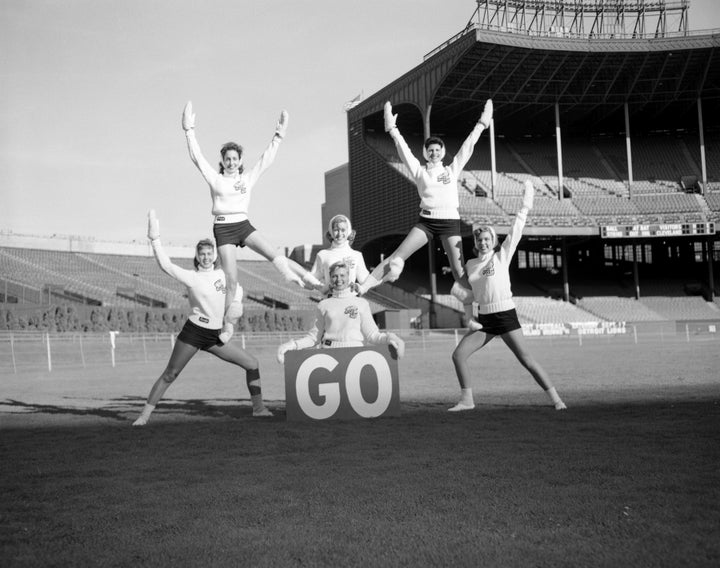
Cheerleading began as the literal leading of cheers, starting with a 1898 Princeton v. University of Minnesota football game when one of the UM students rallied the crowd to root for his team. The effort proliferated, initially through all-male "yell teams," and cheering became organized in the form of fraternities in the early 1900s. It actually wasn't until 1923 that women were allowed to participate. Indeed, cheerleading was created by men.
In the '40s, our boys headed off to serve in WWII and women began dominating the sport. By the '60s, squads were added to the NFL, starting with the then-Baltimore Colts. In 1972, more than a decade after professional cheerleading debuted a uniform of long skirts and sweaters, Texas "Tex" Schramm introduced the Dallas Cowboy Cheerleaders.
Schramm understood that football was primarily entertainment and wanted a way to spice up the game. He considered assembling a group of models on the sidelines, eventually opting for dancers instead. Then, the director of the squad Dee Brock hosted auditions and selected women primarily based on a metric of hotness. With the help of their newly "abbreviated" costumes, the Dallas Cowboy Cheerleaders became the pin-ups of the sports world.
The splashy rise of the Dallas Cowboy Cheerleaders almost immediately translated to film with 1973's "The Cheerleaders," a comedy about -- and here is the plot direct from IMDb, because you really can't make this up -- "a group of cheerleaders from the local high school [who] decide to show their school spirit for their football team by sleeping with the opponents the night before the game so that they can be so worn out the opposition won't be able to play."
There was the similarly intelligent "Swinging Cheerleaders" in 1974 and "The Pom Pom Girls" in 1976, a micro-genre which reached its peak with the actual porno "Debbie Does Dallas" in 1978. By 1979, the iconic status of Schramm's squad inspired the "Dallas Cowboy Cheerleaders" movie, in which a lazily constructed plot has a pre-"Dr. Quinn" Jane Seymour go undercover to audition for the team.
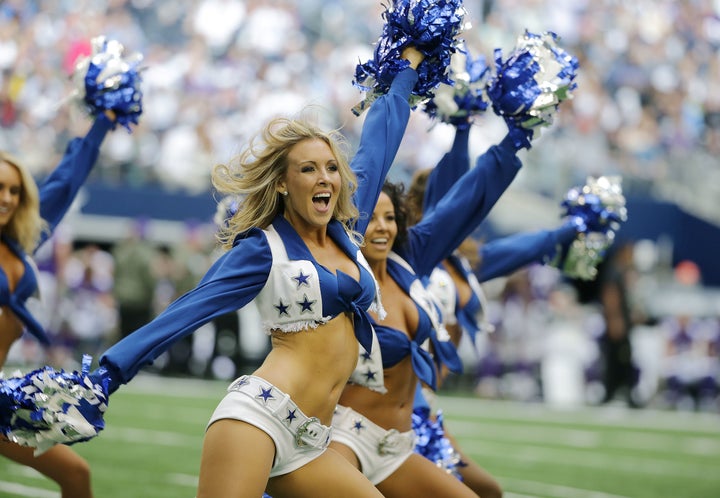
Meanwhile back in real life, the impact of Schramm's innovation on the Cowboys' sidelines began infiltrating colleges and eventually high school leagues. Soon, the sexed-up cheerleader of professional sports sprouted up in educational settings, albeit at a slower pace.
“They weren't fully-fleshed characters, so much as reminders of the social order, the high school hierarchy ever-emphasized by their vapidity, promiscuity, cruelty and/or general gorgeousness."”
Each high school's social infrastructure is different (and terrifying) in its own way, though we can get a pretty solid look at the transition from the timeline of corresponding teen movies. Consider that in "Grease" (1978). Before her "You Better Shape Up" transformation, Sandy had her patent purity defined, in part, by cheerleading. Her high-necked sweater and earnest school spirit were a de facto element of her status as a goody two-shoes "lousy with virginity." Somehow, over the course of the next two decades, that figure evolved into a whip-cream covered Ali Larter as Darcy Sears in "Varsity Blues" (1999).
The reformatted status of the cheerleader was most obviously cemented in pop culture in 1987's "Can't Buy Me Love," in which an impossibly awkward Patrick Dempsey pays the most popular girl in school to be his girlfriend. As Willa Paskin wrote for Vulture back in 2010, "Since the most popular girl in school is a cheerleader, the movie nicely represents the two stereotypes ... that cheerleaders are the most desirable girls, and also the bitchiest."
Throughout the late '80s and '90s, outside of "Buffy the Vampire Slayer" (1992) and "But I'm a Cheerleader" (1999), cheerleaders rarely led films. Most often, they functioned as symbols of popularity. They weren't fully-fleshed characters, so much as reminders of the social order, the high school hierarchy ever-emphasized by their vapidity, promiscuity, cruelty and/or general gorgeousness (see: that dance Kevin Spacey imagines Mena Suvari doing in "American Beauty").
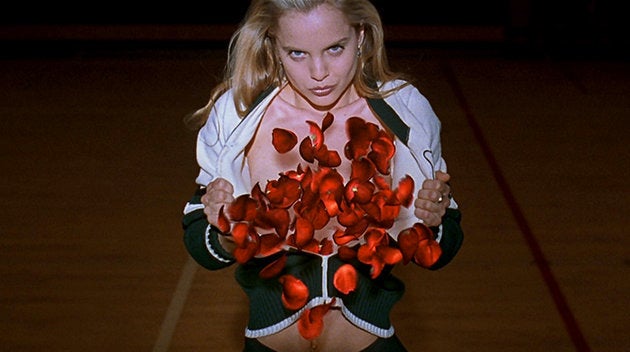
The summer of 2000, then, proved the perfect time for "Bring It On" to explore the theretofore unquestioned omnipotence of the archetype.
"The goal was to re-contextualize cheerleaders, so they weren’t the people you hated," Reed said. "They weren’t the people who were better than everybody else. You got a certain inside look at their world and what drives them."
Dunst's Torrance fit the expectations of the pretty/perky/popular girl, but was also relatable. Reed set out to assure the squad developed into characters his audience not only liked, but sympathized with. For the first time since the late '80s, we got to see cheerleaders as both talented athletes and complex characters with a challenge to overcome.
"Even though Torrance and the other cheerleaders are entitled, snobby kids at the beginning, we get to know them throughout the course of the movie and see all their flaws and insecurities," Reed said. "It was amazing to me that Jessica was able to make these cheerleader characters underdogs."
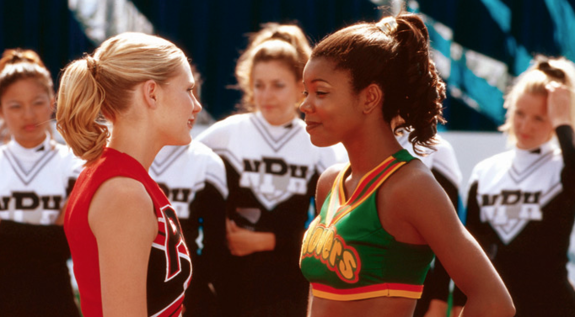
With a background culled in directing the Upright Citizens Brigade sketch show for Comedy Central, Reed was able to animate the arch tone of the script for a film that hid its wit beneath the fluffy, '90s rom-com formula. He understood the issues Bendinger had embedded in her early drafts of "Cheer Fever" and aspired to deliver a nuanced handling of race and sexuality to further deconstruct the cheerleader as a shorthand for "slutty privileged white girl."
"I wanted to make sure the movie’s attitude was forward-thinking, that there was a certain honesty there," he said. "I wanted it to be, in terms of the character's acceptance of the issues of they were facing, a little bit idealized and, hopefully, forward-thinking."
"Bring It On" was, and continues to be, one of the smartest teen-movie takes on cultural appropriation to date. Thanks in large part to Gabrielle Union's powerful interpretation of Clover captain Isis, the film was able to tackle race relations with authenticity, without hoisting up any white saviors or delving into the angry black woman stereotype.
"It was important to really get that character right. I really do credit Gabrielle Union with that," Reed said. "We worked very closely together [to make] that character grounded and realistic. It was always organic to what 'Bring It On' was about."
“['Bring It On'] aspired to deliver a nuanced handling of race and sexuality to further deconstruct the cheerleader as a shorthand for "slutty privileged white girl."”
Sexuality was another element handled with a dexterity not often seen in rom-coms, never mind those set in the inherently ignorant microcosm of high school. Reed and Bendinger set out to create an environment of honesty and openness in place of the Puritanical repression typically surrounding teen sexuality.
That discussion started with the men on the team. Now, the male cheerleader is a figure rarely seen on screen. The few times he does pop up, it's as a joke aimed at male femininity (see: Phil on "Modern Family"). But Bendinger took the two key male cheerleader roles in "Bring It On" -- the super straight Jan and gay-coded Les -- from what she observed at competitions while doing research for the script.
"When I went to competitions, the guys were cut down the middle," she said. "Some were straight, some were gay and the ones that were straight took a lot of shit."
"They said, 'I get to look at ass all day long. My hands are right where they want to be when we’re stunting,'" she continued. "And the gay guys were like, 'Yeah, I get to be with the pretty girls, the popular girls and I get a little bit of protection from that.'"
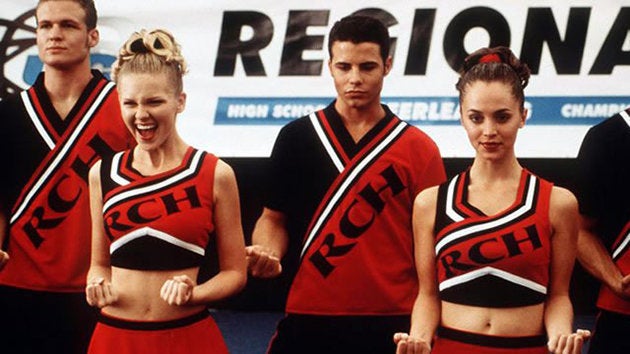
As a feminist, the female iteration of sexuality was a bit trickier for Bendinger to flip on its head. She went with a sort of proto-feminism, girl power take on Torrance and the rest of the squad's approach to the objectification almost inherent in cheerleading.
"I thought of it as this Punky Brewster, spunky, irreverent, very early wave take on it," she said. "Like, 'We’re badasses, shut the fuck up.'"
But the secret ingredient in the feminism of "Bring It On" is not Torrance. It's Eliza Dushku's Missy.
Missy is the outsider, forced to join the squad, because her "school has no gymnastics team / this is a last resort!" She is the viewer's entry point, an interloper who enters the film carting around her own cheerleader stigma much like any non-cheerleader watching the film.
"She really becomes the audience’s eyes and ears into the subculture," Reed said. "It was important to have her there, having the same attitude that audiences might have about cheerleading. That's why they take it so seriously when Eliza's character gets involved and learns first hand what it’s all about."
It's Missy's arc that disrupts the idea of who these girls are as she enters their world. The Toros are not the superficial brats she presumes them to be. They are true athletes, and more important than that, real people she learns to respect.
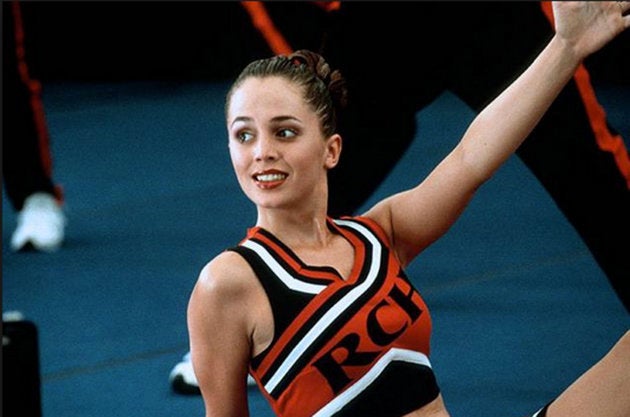
There was an almost immediate decline in the cheerleader archetype in the early aughts, as if pop culture experienced the same reality check Torrance dealt Missy. "Bring It On" was followed shortly by "Sugar & Spice." However, Francine McDougall's 2001 mad-cap comedy featuring cheerleaders-cum-bank-robbers was one of the last true "cheerleading movies."
Post-2000, there was a mass of "Bring It On" sequel spawn: "Bring It On Again" (2004), "Bring It On: All or Nothing" (2006), "Bring It On: In It to Win It" (2007), and "Bring It On: Fight to the Finish" (2009), but a relative lack of major motion pictures outside of "Man of the House" (2005), "Fired Up" (2009) and "Jennifer's Body" (2009). While we still occasionally see the figure popping up in teen movies and TV shows (perhaps most recently on "Heroes," "Glee" or the failed "Hellcats" of 2010) there's nothing even remotely resembling her reign in the '90s.
"Bring It On" marks a nearly precise midpoint between the rise and fall of the cheerleader in pop culture. Reed and Bendinger sent up the first and last intelligent versions of the archetype, before she fell back into a tired replication of her pre-2000 existence. (Ironically enough, it's also not impossible the series of overtly formulaic "Bring It On" sequels -- none of which the original cast and crew were a part of -- contributed to her demise.)
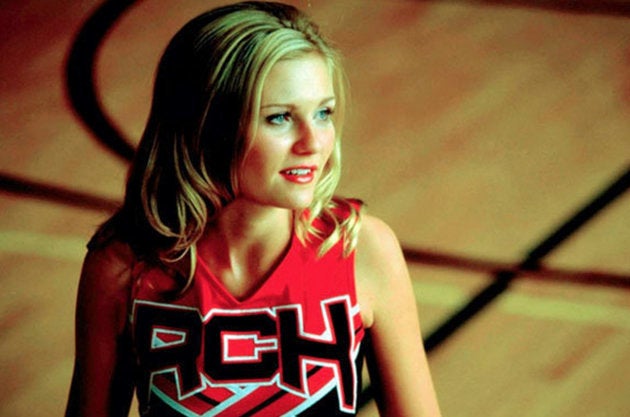
Bendinger attributes the post-"Bring It On" decline of the cheerleader to the girl power movement of the early 2000s and current prominence of third wave feminism. "Cheerleaders are not cool anymore," she said, citing Avril Lavigne and Gwen Stefani's rise to prominence.
"You know, what were Avril and Gwen rebelling against? They were rebelling against being pretty little girls in boxes," Bendinger said. "A cheerleader is exactly that."
“There was kind of a cultural moment of, 'Oh, God! I’m wearing a patriarchal uniform that’s appealing to the male gaze.'"”
- Jessica Bendinger
By the end of the decade, a larger sense of feminist awareness had entered the mainstream. The movement began to explicitly tackle the discussion of women as objects in pop culture. As Bendinger sees it, that enlightenment infected the power of the cheerleader, because we could no longer justify what she had come to stand for.
"As a cheerleader, you're saying, 'I agree to wear this costume and I agree to cheer for the boys,'" Bendinger said. "There was kind of a cultural moment of, 'Oh, God! I’m wearing a patriarchal uniform that’s appealing to the male gaze.'"
What she hits on with the idea of a "patriarchal uniform" is an uncomfortableness with the sport. We refused to respect the pop culture cheerleaders, as well as the modern, professional women who are still often fighting for minimum rights in the work place.
Culturally speaking, we still don't quite know what to make of cheerleaders. There's an itchiness associated with the willingness to be on the sidelines, gyrating in a Band-Aid of a tank top. We might react, if a bit more subtly, in the way of Amy Schumer's character in "Trainwreck," who, while watching the Knicks City Dancers' routine in horror, shouts that they are going to lose women the right to vote.
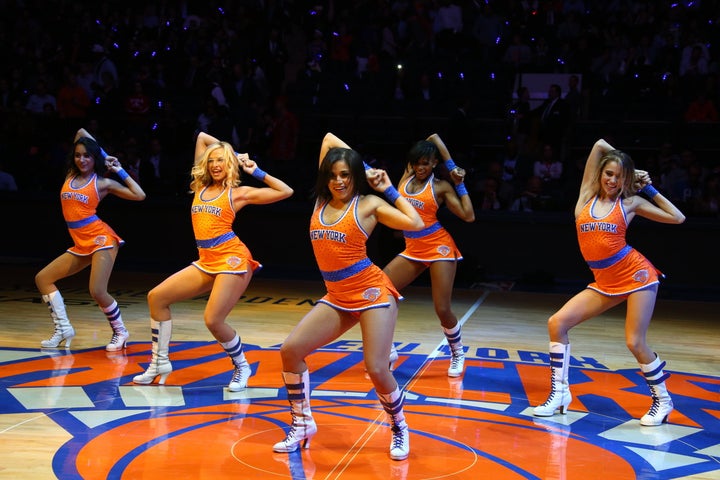
Now, at least, the pop culture cheerleader's power to mutate our conception of the sport is waning.
Beyond the cloud of misogynistic nonsense polluting the figure's presence in pop culture, there are more valid limitations that disqualify her from the mythologized reverence we grant other athletes in film. The conformity of an entire team doing the same moves and ancillary function on which it was founded, undermine the potential for dramatization available to other sports. It's as if the sport was too boring, so we pumped it with Hollywood steroids and turned it into a toxic feminine trope. (Note: That sports movies are male-led 100 percent of the time with the exception of "Bend It Like Beckham" and the Mary-Kate and Ashley classic "Switching Goals," can be filed neatly under "sexism.")
Still, that doesn't explain the derivative insult to women the cheerleader represents as an idea. The cheerleaders we saw in pop culture are as far removed from the Knicks City Dancers as they are from the hardcore athleticism that high school squads have come to be recognized for. The few times the fictional cheerleader does appear today, she's a facsimile of the cultural figure "Bring It On" explored in 2000. The idea of the cheerleader reigns on as a doppelgänger of what she was at her '90s height, copied into some fading version of the already-malformed original.
In a way, it only makes sense the cheerleader is on her way out. After the commercialization of the sport, she was co-opted by film and TV into a symbol of the most negative feminized traits, a pre-packaged set of all our worst ideas about teenage girls. As we move farther away from the convergence of factors that led to the preeminence of the cheerleader archetype that "Bring It On" dismantled, it's getting harder and harder to ignore the fact that the slutty, ditzy mean girl with pom poms was never real in the first place.
Also on HuffPost:
For a constant stream of entertainment news and discussion, follow HuffPost Entertainment on Viber.



